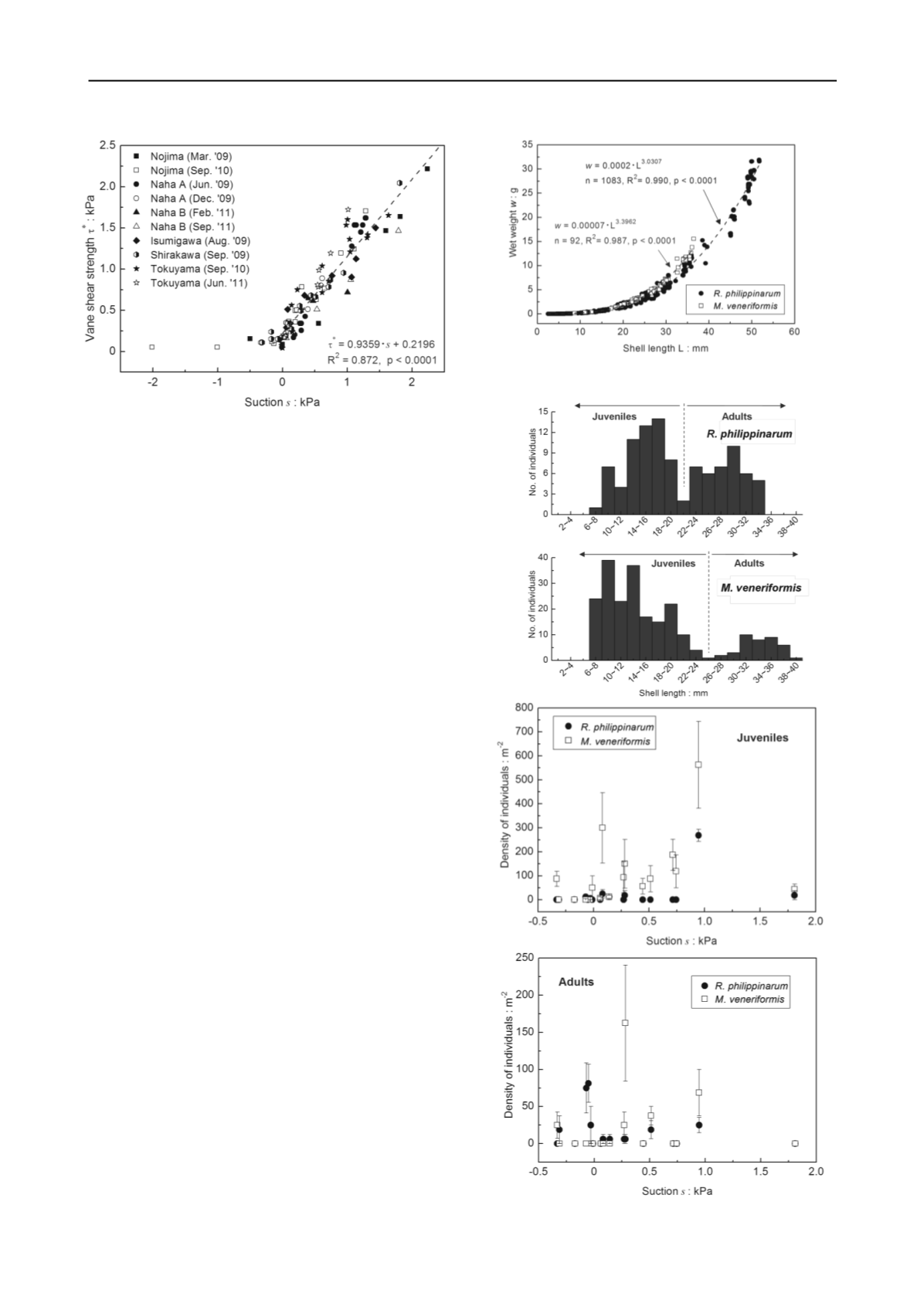
3071
Technical Committee 215 /
Comité technique 215
Proceedings of the 18
th
International Conference on Soil Mechanics and Geotechnical Engineering, Paris 2013
Figure 2. Relationship between suction and vane shear strength at five
natural and artificial intertidal flats
was a strong correlation and unique interrelationship between
suction and hardness of the surficial intertidal flat soils (Fig. 2).
Indeed, the vane shear strength varied by a factor of 20
–
50 due
to suction, that stemmed from the combined effects of suction
development and suction-dynamics-induced cyclic elastoplastic
soil compaction in the essentially saturated states (Sassa and
Watabe, 2007). Such suction is found to be closely linked with
the distributions of the various species as described below.
For the purpose of later discussion, the relationship between
the shell lengths and wet weights of the two different bivalves,
R. philippinarum
(Manila clam) and
M. veneriformis
at the
Shirakawa intertidal flat are shown in Fig. 3. We categorized
adult and juvenile bivalves according to the shell length
distributions in Fig. 4a. The individual densities of the juvenile
and adult bivalves (mean
±
SE) are plotted in Fig. 4b and c. The
figure shows that for both Manila clam and
M. veneriformis,
the
juveniles inhabited the area even where suction developed, but,
the adults, particularly the adult Manila clams inhabited only the
waterfront area where suction did not develop. Also, the peak
density of the adult
M. veneriformis
manifested where the
developed suctions were higher than those for the adult Manila
clam. These field results are well consistent with the ecohabitat
chart indicating the following. Namely, the burrowing
capability of the Manila clam decreased considerably toward
adult stages when the shell lengths exceeded 20mm
corresponding to the wet weigths 1.5 to 2g in Fig. 3. This means
that the adult Manila clam could not effectively burrow in
denser soils as a consequence of the suction dynamics.
Furthermore, the suitable geoenvironment for the adult
M.
veneriformis
was above that for the adult Manila clam in the
chart. This fact also conforms to the observed results.
Figure 5 shows the relationship between suction and
burrow densities of the sand bubbler crab
S. globosa
and the
decapod crustacean
C. japonica
at the Naha and Isumigawa
intertidal flats. Both species inhabited the geoenvironment
particular to each species, irrespective of the survey locations
and periods. In fact, the individual densities increased markedly
at suction equal to 1kPa for the
S. globosa
, and about 0.2kPa for
the
C. japonica
. This observation conforms quantitatively to the
ecohabitat chart showing that the suitable geoenvironment for
S.
globosa
was well above that for
C. japonica
.
Figure 6 shows the relationship between suction and
individual densities of Arthropoda, Mollusca, and Annelida at
the Tokuyama artificial intertidal flat. The survey was conducted
soon, one and half year, after the reclamation. It is seen that in
the unsaturated region where suction exceeded the air-entry
suction of the soils, the densities of all species declined,
indicating the importance of water retention in soils for the
survival of species. In the saturated region, the density of
C.
erythraeensis
outnumbered the other species. This fact is also
Figure 3. Relationships between shell length and wet weight of
R. philippinarum
and
M. veneriformis
Figure 4. Relationships between suction and individual densities of the
two different bivalves at the Shirakawa intertidal flat
(a)
(b)
(c)


